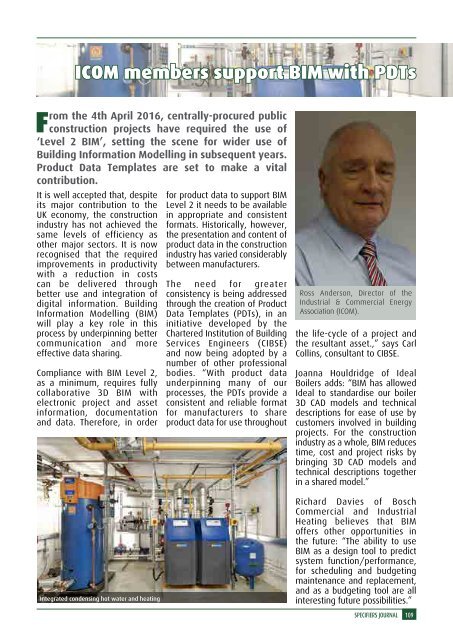Specifiers Journal 2016
Specifiers Journal 2016
Specifiers Journal 2016
Create successful ePaper yourself
Turn your PDF publications into a flip-book with our unique Google optimized e-Paper software.
ICOM members support BIM with PDTs<br />
From the 4th April <strong>2016</strong>, centrally-procured public<br />
construction projects have required the use of<br />
‘Level 2 BIM’, setting the scene for wider use of<br />
Building Information Modelling in subsequent years.<br />
Product Data Templates are set to make a vital<br />
contribution.<br />
It is well accepted that, despite<br />
its major contribution to the<br />
UK economy, the construction<br />
industry has not achieved the<br />
same levels of efficiency as<br />
other major sectors. It is now<br />
recognised that the required<br />
improvements in productivity<br />
with a reduction in costs<br />
can be delivered through<br />
better use and integration of<br />
digital information. Building<br />
Information Modelling (BIM)<br />
will play a key role in this<br />
process by underpinning better<br />
communication and more<br />
effective data sharing.<br />
Compliance with BIM Level 2,<br />
as a minimum, requires fully<br />
collaborative 3D BIM with<br />
electronic project and asset<br />
information, documentation<br />
and data. Therefore, in order<br />
Integrated condensing hot water and heating<br />
for product data to support BIM<br />
Level 2 it needs to be available<br />
in appropriate and consistent<br />
formats. Historically, however,<br />
the presentation and content of<br />
product data in the construction<br />
industry has varied considerably<br />
between manufacturers.<br />
The need for greater<br />
consistency is being addressed<br />
through the creation of Product<br />
Data Templates (PDTs), in an<br />
initiative developed by the<br />
Chartered Institution of Building<br />
Services Engineers (CIBSE)<br />
and now being adopted by a<br />
number of other professional<br />
bodies. “With product data<br />
underpinning many of our<br />
processes, the PDTs provide a<br />
consistent and reliable format<br />
for manufacturers to share<br />
product data for use throughout<br />
Ross Anderson, Director of the<br />
Industrial & Commercial Energy<br />
Association (ICOM).<br />
the life-cycle of a project and<br />
the resultant asset.,” says Carl<br />
Collins, consultant to CIBSE.<br />
Joanna Houldridge of Ideal<br />
Boilers adds: “BIM has allowed<br />
Ideal to standardise our boiler<br />
3D CAD models and technical<br />
descriptions for ease of use by<br />
customers involved in building<br />
projects. For the construction<br />
industry as a whole, BIM reduces<br />
time, cost and project risks by<br />
bringing 3D CAD models and<br />
technical descriptions together<br />
in a shared model.”<br />
Richard Davies of Bosch<br />
Commercial and Industrial<br />
Heating believes that BIM<br />
offers other opportunities in<br />
the future: “The ability to use<br />
BIM as a design tool to predict<br />
system function/performance,<br />
for scheduling and budgeting<br />
maintenance and replacement,<br />
and as a budgeting tool are all<br />
interesting future possibilities.”<br />
SPECIFIERS JOURNAL<br />
109







